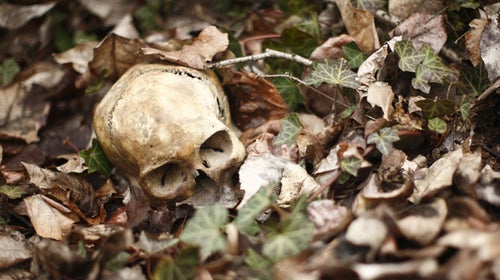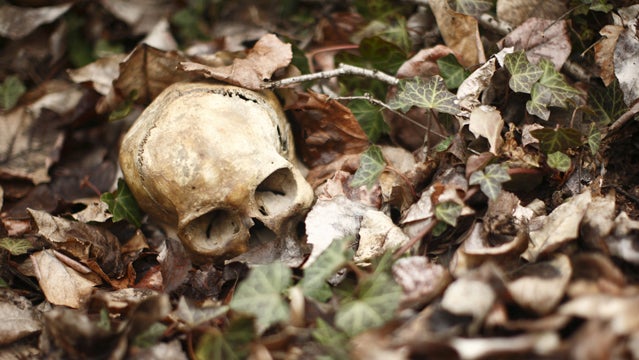Risk is a large part of what attracts us to adventure—but it’s worth taking a look at how it can all go wrong. We bring you the science behind 10 of the most terrifying, laughable, painful, and worst ways to die outside.
Falling to Your Death
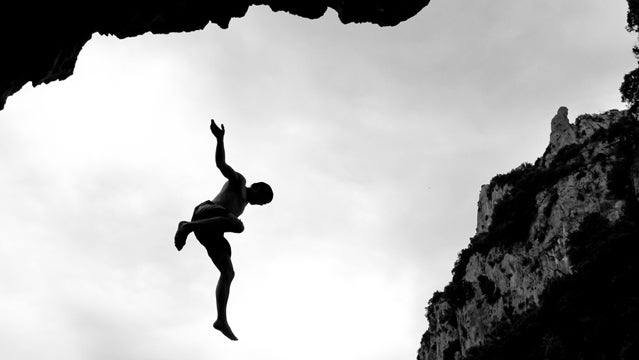
There is no time to feel fear really. Within a few hundredths of a second of buttering off the hold, your “startle reflex” kicks in. Your arms fly outward as if to grab something, but there is nothing to grab. You’ve been free-soloing—climbing without a rope or a partner to catch your fall. What were you thinking? You might ask yourself that, but it’s too late. Gravity accelerates your body. You plummet 30 feet—the equivalent of a three-story building—in 1.4 seconds, the time it takes to say, “How are you this morning?”
Crack! Your right leg strikes a projection from the wall and you tumble another 20 feet before landing on a granite ledge. The valley is still a hundred feet below.
You try to breathe, but the force of the fall has compressed your diaphragm, pushing the air out of your lungs. You manage a short spasmodic gasp, then another. A wave of nausea wells up from your gut and you vomit your breakfast in a long arc over the ledge. Your body instinctively knows that it must rally its defenses after such a severe blow. Digesting food would sap too much energy.
You notice something—a stick, it looks like—protruding from the stretchy nylon of your climbing pants. You look more closely. It’s your right femur, shattered in an open fracture, blood oozing from the torn flesh of your thigh. Oddly, it doesn’t hurt—not much, or rather, not yet. Your body blocks the pain by plugging the nerve endings with endorphins. Meanwhile, you are also experiencing what emergency-room doctors call “the golden hour,” the immediate aftermath of a trauma, when the human body can more or less hold itself together and maintain blood pressure despite bleeding. You feel a dull ache in your trunk. When you hit the ledge, you not only broke the ninth through twelfth ribs on your left side, but you split open your spleen, the fist-size organ to the left of the abdomen that filters blood. Your blood supply is now slowly leaking into your abdominal cavity.
You punch 911 into your cell phone, but the signal is blocked by the canyon wall. When a hunter spots your body several years later, the bones of your fingers will still be wrapped around the phone’s weathered plastic casing.
Death by Cassowary Bird
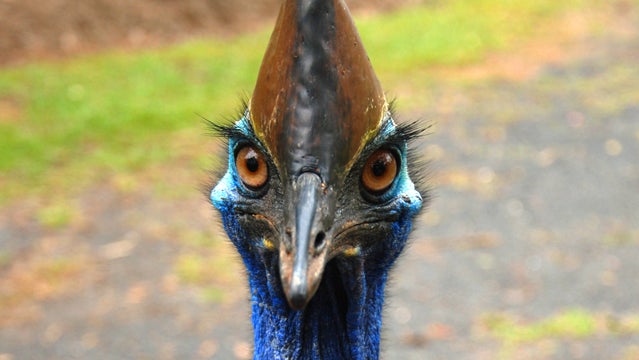
Twilight falls on northeastern Australia. Beer in hand and with the warm glow of the campfire illuminating the surrounding foliage, you spot a dart of blue through the green and hear a low-pitched boom—too deep to be a bird, too high to be thunder.
Curious and a bit tipsy, you venture forth to explore. Meeting you eye-to-eye is a 6-foot-tall, 129-pound bird. Your eyes quickly scan the beast but miss the 5-inch dagger-like claw on its middle toe. The bird looks tame, but it has repeatedly been fed by people and is now expecting the same from you.
You know not to feed the wildlife, but you toss a beer can its way. When the bird doesn’t move, you move forward and make a fake charge for the (drunken) hell of it. The creature cocks its head and you think it’s finally going for the brew. But instead it lunges toward you. Suddenly, you’re one of the 221 recorded victims of a cassowary attack. You laugh and turn to run, thinking the modern-day velociraptor will be easily distanced. You’re wrong. The cassowary tops out at 31 mph and easily keeps pace with your drunken amble.
The bird kicks and you stumble across a log. In a flash, it leaps nearly five feet into the air, landing beside your neck. You cover your face in fear as the cassowary nears. With one powerful kick, it opens a half-inch gash, nicking your carotid artery.
Hearing your screams, a nearby camper comes to your aid, shooing off the bird. Within seconds of his arrival and eight minutes after the gash was formed, you slip into unconsciousness. The camper tries to staunch the flow of blood, but it’s no use. You’re the second person since 1926 to die by cassowary.
Heat Stroke

Body Temperature: 101 Degrees Fahrenheit: Never mind that the air temperature is way too hot for hill climbing (92 degrees and rising). If you reach the top of the pass, you’ve won!
102 Degrees: With each powerful downstroke of your pedals, your core temperature climbs a tiny fraction of a degree. You’ve entered the “fever of exercise” zone between 100 and 105 degrees—temperatures that trained athletes endure without harm.
103 Degrees: Every nine seconds, each of your two million sweat glands squirts a drop of moisture through a pore, then recharges. Without the cooling mechanism of sweat, at the fierce pace you’re riding, your body temperature would rise 0.9 degrees every minute and you’d reach heatstroke range within 12 minutes.
104 Degrees: The road steepens. You stand on your pedals. Painful knots form in your biceps, calves, and abdominal muscles—heat cramps, believed to be the result of sweating out so much sodium. Though your heart pounds, it can’t keep your veins and arteries filled to capacity; they’ve dilated to their maximum to bring hot blood from your overheated core to your sweat-cooled exterior. Lacking pressure, blood flow to your brain slackens. Your vision turns fuzzy.
105 Degrees: You begin to hallucinate. The searing pain in your thighs suddenly eases. The finish line is just ahead. You know victory is yours but for some reason no one is there waiting. You veer off the road and tumble down an embankment. Everything goes black.
106 Degrees: Lying unconscious, you suffer a heatstroke. Your cellular metabolic rate—how fast your cells turn fuels into energy—accelerates. Metabolism is now occurring more than 50 percent faster than at normal temperatures. Your body is literally cooking itself from within.
107 Degrees: You vomit repeatedly, and your sphincter releases.
109 Degrees: Seizures ripple through your muscles.
110 to 113 Degrees: Mitochondria and cellular proteins dissolve. Your heart and lungs start to hemorrhage. Blood coagulates in your veins. Heat damages your liver, kidneys, and brain and perforates your intestinal wall. Toxins emitted by spent digestive bacteria now escape into your bloodstream, perhaps triggering septic shock. Your heart stops.
They find you that evening, long after the race has ended. They can’t locate a pulse, but your lifeless body is still warm to the touch.
Mauled by Bears

It’s another serene evening in the Sierra Nevada as you watch the sun set into the granite realms surrounding your cabin’s porch. The distant rumble of thunder seems out of place until you look to your left and see a massive black bear charging toward you with a thread of drool hanging from its mouth.
You know fatal black bear attacks are extremely rare—they kill an average of two people per year—so you hesitate. But this is a lone male, hungry, and suffering from food stress*. He smells the trash outside your cabin, and now he’s hunting you.
You leap up and run inside to what you assume is the safety of the log cabin. A minute later the animal smashes through the window, a determined scowl on its ugly mug. Banging pots and pans together to no avail, you retreat to the back room. Ordinarily, the bear would flee. But today, he follows.
It hits you in the shoulder with a powerful shot, sending you to the floor. Holding you down with its paws, the bruin begins scalping you with its front teeth. You hear it chipping away at your skull as pain sets your nerves on fire. In a desperate attempt to fight the animal off, you roll over on to your back—exposing your throat. The bear bites down.
The next day wildlife authorities shoot the animal as it attempts to break into another house. They find human remains in its stomach.
*��Fatal black bear attacks are incredibly rare, but they do happen. A that male bears commit 92 percent of the attacks and are often influenced by a lack of food and the availability of human food or garbage.
Drowning

0 Minutes, 3 Seconds
Oh, shit! That’s your only thought as your kayak wheels upside down through the air over the huge boulder that sits midstream in the river, creating an enormous hole. You manage to suck in one big breath—five liters of air before going under. Since air is made up of four-fifths nitrogen and one-fifth oxygen, this gives you one precious liter of oxygen trapped in your lungs. Plunging headfirst into the hole, you’re instantly ripped out of the kayak. The cold water slapping your face triggers your mammalian “diving response”: Your heart rate drops and your veins and arteries constrict to channel the oxygenated blood to your brain and organs instead of to your limbs.
0 Minutes, 12 Seconds, 825 Milliliters of Oxygen Remaining
The average human can hold his or her breath for about 90 seconds before blacking out. Already, you can feel the strain in your lungs. Sensors in your brain are “tasting” the buildup of carbon dioxide in your blood and signaling your lungs to exhale.
0 Minute, 37 Seconds
Your blood, normally a rich, oxygenated red, is turning blue. Dimly, you feel your arms and legs burn from the buildup of lactic acid caused by oxygen deprivation. Your head breaks the surface of the water and you let out a great sigh of carbon dioxide. Just as you start to take a breath, the hole pulls you back under. You gag, your larynx in spasms as it reflexively closes to keep water out of your lungs.
1 Minute, 23 Seconds, 220 Milliliters of Oxygen Remaining
You lose consciousness. The water you inhaled has washed out the surfactant—a protein coating—that keeps your lungs’ air sacs from collapsing. If rescued now, you could die a few hours later of “secondary drowning” as your damaged lungs fill with fluid.
4 Minutes, 21 Seconds
Your feeble heartbeat pushes some residual oxygen to your brain. On dry land, brain damage begins roughly four minutes after breathing has stopped; after ten minutes there is almost zero chance of recovery. These times can decrease when the victim is underwater, particularly in cold water.
19 Minutes, 36 Seconds
Except for the faintest electrical impulses, your brain has stopped functioning. Your body normally would sink, then rise to the surface as it filled with gases during decomposition. With the life jacket still on, it gently spins into an eddy a half a mile downstream.
Poisoned by a Blue-Ringed Octopus
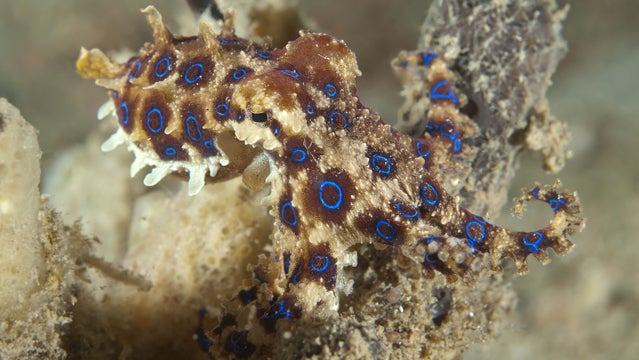
Within a few seconds of pulling the octopus from the water, it changes color, displaying a set of blue rings. And when you go to drop it back into the ocean, you notice a dot of blood on your hand. You hadn’t even felt the bite.
There are no fangs, no sting. But you’ve been bitten by a blue ringed octopus, and the neurotoxin tetrodotoxin—10,000 times more toxic than cyanide—was injected 5mm deep into the skin, and is making its way through your body. Within minutes, your mouth goes dry. Soon after, your face and tongue go numb. It reminds you of the time you tasted fugu until you lose the ability to speak and walking becomes impossible.
Your girlfriend calls for an ambulance after you collapse, but you remain conscious as the toxin causes total body paralysis. Paramedics place you on your side to prevent you from choking on your own vomit, but they’re at a loss of what else to do—and you’re unable to tell them your suspicions about the octopus.
Fifteen minutes after being bitten, the muscles responsible for breathing are paralyzed. As you slip into unconsciousness, your heart continues beating—until asphyxia sets in.
Poisoned by a Sea Snail
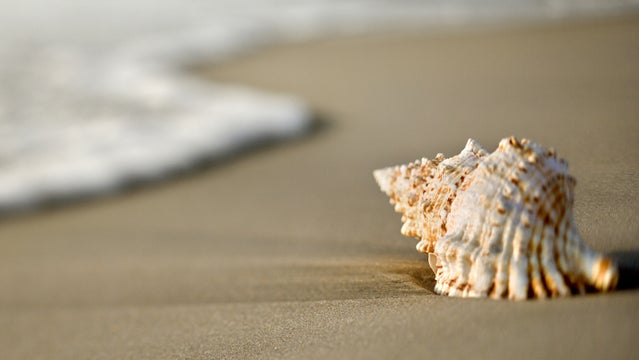
The beach is littered with shells, but your eye alights on a cone-shaped snail with alternating beige and rust tiles. You scoop down to pick it up, placing it in your pocket. Almost immediately, you suffer an intense pain in your right leg and an immediate shortness of breath.
You figure one of the shells must have rubbed your leg the wrong way, so you dump them out and continue walking back to camp. As you head back to your tent, your walking becomes labored. Your right leg has gone numb. Concerned, you pull up your shorts and notice a tiny mark that looks something like a bee sting.
Fifteen minutes after the snail harpooned a lethal mixture of more than six peptides into your body, you develop a severe headache. Your right leg continues to swell, so you pop an aspirin for the pain and waddle over to the communal fire. Soon, you begin vomiting. With your appetite gone, you limp back to your own tent.
Your speech slurs—not that there’s anyone to hear you—as paralysis sets in. The snail’s venom blocks calcium and sodium channels in your central nervous system, leading to paralysis.
When a concerned friend comes to check in on you in the morning, he finds your face covered in vomit. There is no pulse.
Stung to Death by Bees
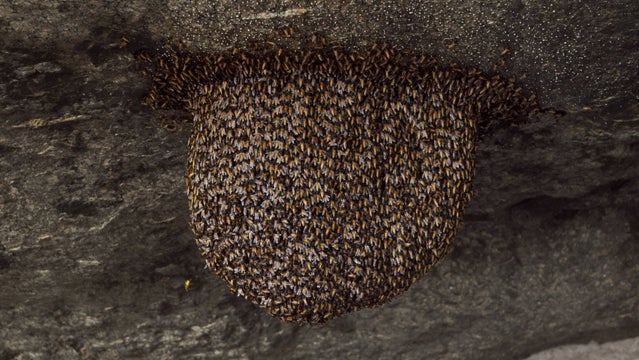
It starts as an indistinct hum. You reach for the next hold, ignoring the buzzing in your ears when you feel a pinprick on your right thumb. Confused and alarmed, you look up to see a beehive.
The first few pinpricks don’t really endanger you—you’re not allergic, you think. But they’ve sealed your fate. Each sting is accompanied by an alarm pheromone that smells vaguely like bananas and sends the hive of bees into a defensive frenzy.
The bees begin to pour out of the hive. They sting every inch of your body, but seem particularly drawn to your head and neck—areas of high vasculature. Fighting to swat them away, you swallow a fistful of the bees, which proceed to sting the inside of your throat.
Your friend belays you down safely, but you’re covered in over a thousand stings. The human lethal dose for honey bee stings is estimated to be between 500 to 1200 stings, if you receive medical care. Off the cliff, you begin to vomit and suffer from diarrhea and incontinence, but your friends help you to the trailhead where paramedics take you to the hospital.
A day later, you’re released from the hospital in good spirits. Unbeknownst to you or your inexperienced doctors, you’ll be dead by the end of the week. Proteins in the venom are dissolving blood cells and muscle tissue, releasing debris. As the debris accumulates, your kidneys become clogged, your begin to experience renal failure. Two days later, you’re back in the hospital and die before doctors can begin dialysis.
Death by Pinecones
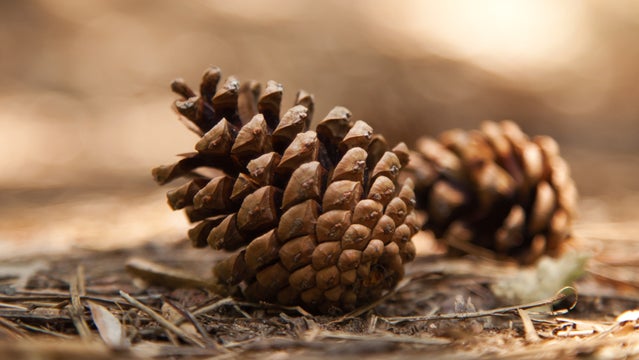
You don’t know it, but something peculiarly sinister waits in the branches above. A 22-pound cannon ball breaks from its branch and and hurtles toward your head as your stroll underneath the ancient bunya pine.
The giant pinecone, falling from a limb 90 feet off the ground and accelerating at a speed of 32 feet per second, will land with the force of a bowling ball dropped from a nine-story building.
You hear a crash above you and look up just in time to see the spiny, green aerodynamic object plummeting toward your face. If you’re not wearing a hard hat, it’s lights out.
Killed by a Beaver

The beaver pond looks so inviting. With temperatures hovering around 90 degrees, you decide to go for a quick dip after a long hike.
You’re swimming back to shore when searing pain courses up from your ankle to your thigh. Your right leg dangles uselessly as you flail helplessly in the shallow water. Clawing your way through a slimly growth of algae, you manage to limp on to the beach.
As you drag yourself from the water, you see a thick ribbon of red trailing back into the pond. Blood streams from your lower leg as you dial 911 with shaky fingers on the cell phone left among your belongings.
You never see the aquatic culprit, a fiercely territorial rodent with powerful jaws capable of felling a 3-foot-wide tree. By the time the medics arrive on scene, you’ve bled to death from a severed artery and a torn Achilles tendon.
